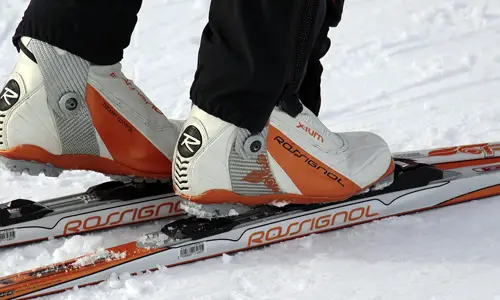Table of Contents
In XC skiing, the material of the skis plays a vital role in their performance on the slopes. As skiing evolved, so did the stuff these cross country skis are made of.
The cross-country skis are made of multiple layers of materials that include either wood or polyurethane foam. Many cross country ski construction feature an aluminum ski core. The most common types of wood that are used in skis include poplar, ash, beech, and Okoume. The outer part of the cross-country skis can be made using fiberglass, epoxy, or carbon fibers.
There are two main ski components that play an important role in a cross-country ski construction:
- The material these cross country skis are made of, and
- The process by which these skis are constructed.
The Material
The inner core of your cross-country ski is considered as the most important part of the ski as it is responsible for the ski’s strength and flexibility. This inner core, which was earlier made of wood, is now constructed using a variety of materials. With the introduction of metal in the cross-country ski, the material of your skis is now of utmost importance.
Many cross-country ski manufacturers still prefer wood as the inner core, whereas there is another section of XC ski manufacturers that vouch for foam.
Wooden Core
With wood as the inner core, the cross country ski manufacturers need extreme precision while matching the amount, type, style, and cut of the wood used in each pair of skis. It is extremely important as some slight mismatch can result in skis in both your legs acting in an entirely different manner. Since you are at a high speed while cross country skiing, this factor is of utmost importance as you do not want both the skis to perform in different ways. In the cross-country ski industry, normally, beech, poplar, Okoume, and ash tree woods are used to manufacture the wood core skis for cross country.

Foam Core
On the other hand, many modern skis were replaced by foam cores. The foam based inner core makes the skis lighter than their counterparts. Also, the construction of a foam-based cross country ski is relatively easier as it absorbs different vibrations and facilitates the manufacturer in designing the curves. And since most skis with foam-based cores are made from polyurethane, these cross country skis end up costing less than the ones with wood cores.
Aluminum Core
You must have also heard about another material used in the cross country skis – the aluminum-cored skis. In these skis, the aluminum metal is patterned in the form of a honeycomb. The positive aspect of these strong aluminum-based cross country skis is that they are lighter as compared to the wooden-core skis, but are way better in terms of flexibility.
Exterior Part
The exterior part of all cross country skis can be manufactured using either fiberglass, carbon fibers, or epoxy.
Ski Base
The base of cross country skis – the bottom part of the skis that touch the snowy slopes – is generally made using polyethylene. The downside of using polyethylene base material in cross country skis is that it gets damaged to scratching. When you are on a cross country ski adventure, skiing alongside stones and ice, resulting in constant friction on this base, and as a result, the polyethylene base gets scratched. Also, the harsh UV rays break down polyethylene. For this reason, you must have noticed that many ski repairing companies and cross country skiers themselves use a polyethylene candle wax to fix these scratches.
Ski Edges
The edges of your cross-country skis are generally made of metal, primarily steel. This metal edge provides extra strength to your cross-country skis.
The Process of Ski Manufacturing
The cross country skis, also referred to as Nordic skis, differ in their design and style. Although these cross country skis appear to be just a piece of board gliding on ice, there is more complexity in its manufacturing. The cross country skis are designed based on the important principles of engineering, physics, as well as material science.
There are two main processes used while manufacturing cross country skis.
Compression Molding
Compression molding is often used to make cross-country skis. This process requires heat and pressure to bond all the components of the layers.
- First, the gliding surface is constructed by using a friction resistant material made up of preassembled fiberglass laminate and polyethylene thermoplastic. This surface which makes the undersides of the cross-country skis are cut with the help of a computer-operated blade.
- Then steel-edges are glued to give the cross-country skier the grip that he/ she needs on the slopes. With the help of a spray, the glue is dried in a faster manner so they can apply epoxy.
- At the back of the cross country skis, there is a rubber shock absorber along with a strong and durable plastic-based heel piece protector.
- Then the cross country ski’s core layer made out of wood is placed and glued together making sure all the layers align.
- For some added strength, an extra layer of epoxy and fiberglass are then added to the top layer. The laminated wood core is now fully protectedin a sandwich construction between the two layers.
- Next comes the decoration in which a plastic layer is added. Everything is clamped together so that there is no layer sliding off out of place.
- Once this is done, the XC ski is then taken to a pressing mold for compression. Here the cross country skis are heated at 85 degrees Celsius. As a result, the epoxy comes into action by hardening up. This could take somewhere between 12 to 15 minutes. The exact time depends upon the thickness of the cross country ski.
- Now the excessive material around the cross country skis is trimmed off. This is more like a rough cut.
- For finer shaping, the edges of the XC ski are sandpapered using a machine until they are nice and smooth.
Reaction Injection Molding
There is another method of creating cross-country skis known as the reaction injection molding.
- In this method, the top layer of the cross country skis – the fiberglass epoxy sheet is placed in the ski mold.
- Then comes the ski gliding surface which is made of a preassembled sheet of fiberglass and polyethylene.
- Instead of a wooden core, a strong and resistant layer of plastic is pressed onto the cross country skis. As a result, within three seconds the polyurethane inflates and eventually hardens.
- After eight minutes, it is hard enough to be taken out of the mold.
- The cross country skis are left aside for as long as 8 hours, after which these skis become super strong, and the three layers become a single-layered ski strong enough to hold the weight of the cross country skier.
- The skis are then taken for the finish touches. Their edges are trimmed, and the gliding surface is properly sanded. A groove is also carved that provides the cross country ski with more stability.
- The cross-country skis are then decorated. First, the background color is added in the form of a quick-dry way, and then the designs are manually added.
- In order to protect the colors, a coat of varnish (that is transparent) is applied at the end.
Conclusion
The weight of your cross country ski along with its strength and durability factors plays an important role in its functionality. This is because your cross country ski needs to be light in weight – light enough to travel on the snow, yet rugged and durable enough to bear sudden shocks of the cross country skier. When the skier jumps or suddenly stops, the cross country ski needs to absorb the sudden movement as well as the resistance from the ground below while bearing the skier’s weight.
The cross country skis are also made to be waterproof. They need to resist the constant damage from ice and rocks, especially as the skis are moving at an extremely high pace. All these factors need to be considered while manufacturing and purchasing a cross country ski.
Cross country skiing is no more a mere means of transportation like olden days. It has evolved into a recreational and competitive sports activity. Different kinds of cross country skis are made of different materials, and different cross country skiers have their own preferences. But one thing is for sure, whether you have a material preference in cross country skis are not – you are bound to get a great deal of fun while exploring the endless snow-covered terrain. Happy cross country skiing!


